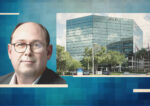After leaving his eponymous firm last month, Holly Real Estate, Miami real estate power broker William Holly returned to Cushman & Wakefield — after a 12-year absence — as an executive director. Holly Real Estate was a general real estate services company, including development and brokerage, and had a particular focus on green development. The full-service company developed several environmentally-friendly buildings across Miami, highlighted by Miami Green at the edge of Coral Gables. Holly talked to The Real Deal about his first two weeks on the job, what he learned in his 12-year hiatus from Cushman and the strength of the Airport West office market.
What motivated the return to Cushman?
I’ll tell you — Cushman is a company on the move. I met with Glenn Rufrano, the CEO, and Jim Underhill, head of the brokerage for the Americas, and Bill Magner, who heads the [Mid Atlantic and South East]. They had all the right answers. What they’re doing is taking a good company and it’s going to create a great company. It had to do with all the leadership, coupled with Shane Soefker [Cushman’s South Florida branch manager] whom I’ve known for almost 10 years.
What has it been like being back at the firm?
The nice thing is — I was here before… many of the brokers that I worked with 12 years ago are there today. So we have relationships, and that made it very easy. But I’m a different person. The experiences that I’ve had the last 12 years — first of all, running a publicly-traded, international real estate company, heading a region, having helped finance projects, I’ve come back with a fresh focus on how I look at the business. So I’ve been very pleasantly surprised with the reception I’ve gotten, from existing clients and new clients, with my renewed focus back.
How would you describe your first few weeks?
I’ve been working with five different tenants — in the market office tenants looking for office space in downtown Brickell, Airport West and Coral Gables. The activity level has been a whirlwind since I got back.
You mentioned Airport West — how would you categorize the state of that particular submarket?
On the office side, I see that as the number one corporate market in Miami. There are more Fortune 1000 corporations having their Latin American sales headquarters, their South Florida headquarters, in the Airport West market than anywhere else. So with the pullback of corporate America, and the efficiency driving corporate America, we’ve seen a lot of space free up in that market — so it’s a very competitive market. And it’s definitely a tenant’s market. The other interesting thing is the quality of office stock in that market has continued to improve. You look at 10 years ago versus today, buildings just being developed today are truly Class A, really nice-quality projects.
What have you seen in the first quarter?
Everyone knows about the high occupancy and low [rental] rates. I think that what you’re starting to hear about is the increased leasing activity. That’s what we see. Two of the tenants I took around the market last week were expanding, and that’s healthy for the market for the long term.
There are two large, new towers, 1450 Brickell and Wells Fargo Financial Center, along with soon-to-open 600 Brickell, downtown. How long will it take for the market to adjust?
I think it’ll be several years, because not only do you have the new towers, but you have the corresponding other towers, like the Southeast Financial Center, losing, for example, [tenant] Bilzin Sumberg, then Wells Fargo, in back-to-back transactions. It leaves a lot of space, not only in new buildings, but a lot of space in old buildings.
What’s your longer-term outlook for downtown?
I think this market is always going to have the haves and have-nots. The buildings that lost tenants are going to need to drop rates, and the buildings that are filling up will need to increase their rates. It’s not a market-wide phenomenon — you’re seeing a building-to-building change in the last six months.



